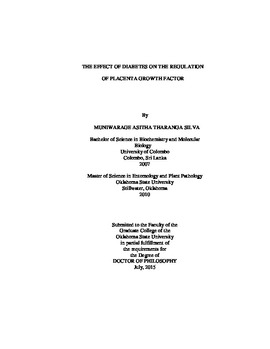| dc.contributor.advisor | Lloyd, Pamela | |
| dc.contributor.author | Silva, Muniwarage Asitha Tharanga | |
| dc.date.accessioned | 2016-09-29T18:42:58Z | |
| dc.date.available | 2016-09-29T18:42:58Z | |
| dc.date.issued | 2015-07 | |
| dc.identifier.uri | https://hdl.handle.net/11244/45314 | |
| dc.description.abstract | Cardiovascular disease is the number one cause of death worldwide, representing 31% of all global deaths. Among them, over 14 million are due to ischemic coronary heart disease and stroke. Additionally, peripheral artery disease is the major cause of limb amputations in the US. Type 2 diabetic patients are at highest risk of mortality and morbidity due to ischemic cardiovascular disease. Arteriogenesis is the normal physiological response to occluded blood vessels by structural remodeling of preexisting collateral arteries. Although, arteriogenesis is vital for diabetic patients, diabetes inhibits this process with poorly known mechanism. | |
| dc.description.abstract | Placenta growth factor (PLGF) is a key mediator of arteriogenesis. Genetic deletion of PLGF reduced arteriogenesis while over expression resulted enlarged stable vessels making it a suitable therapeutic target for compromised arteriogenesis in diabetes. However, little is known about PLGF regulation. Our previous work suggests that PLGF is sensitive to reactive oxygen species. Since physiological oxidative balance is altered in diabetes, PLGF expression and regulation may be affected by diabetes contributing to reduced arteriogenesis in diabetes. | |
| dc.description.abstract | Here, we report that PLGF is down regulated in mouse heart, skeletal muscle and pig coronary arteries and upregulated in mouse aorta under diabetes related metabolic conditions. PLGF inhibition in vivo is highly correlated with hypercholesterolemia, oxidative stress (heart and coronary arteries) and hyperinsulinemia (skeletal muscle). In vitro finding suggests advanced glycated end product mediated inhibition of PLGF in multiple cell types. In a physiologically relevant model of hind limb ischemia, we found that PLGF is shapely elevated in skeletal muscle. However, this stimulation is severely hampered in the presence of diabetes associated metabolic conditions. | |
| dc.description.abstract | In conclusion, the research presented in this dissertation identifies key metabolic parameters that affect PLGF expression under basal level as well as in the presence of arteriogenic stimulus. Our data from large animal, small animal and multiple cell types are consistent and strongly suggest similar mechanisms of PLGF inhibition occur in diabetic patients. These findings benefit the research aiming to minimize ischemic cardiovascular disease in diabetic patients. | |
| dc.format | application/pdf | |
| dc.language | en_US | |
| dc.rights | Copyright is held by the author who has granted the Oklahoma State University Library the non-exclusive right to share this material in its institutional repository. Contact Digital Library Services at lib-dls@okstate.edu or 405-744-9161 for the permission policy on the use, reproduction or distribution of this material. | |
| dc.title | Effect of diabetes on the regulation of placenta growth factor | |
| dc.contributor.committeeMember | Hinsdale, Myron | |
| dc.contributor.committeeMember | Lacombe, Veronique | |
| dc.contributor.committeeMember | Smith, Brenda | |
| osu.filename | Silva_okstate_0664D_14225.pdf | |
| osu.accesstype | Open Access | |
| dc.type.genre | Dissertation | |
| dc.type.material | Text | |
| thesis.degree.discipline | Veterinary Biomedical Sciences | |
| thesis.degree.grantor | Oklahoma State University | |
